
Vanessa is a genus of brush-footed butterflies in the tribe Nymphalini. It has a near-global distribution and includes conspicuous species such as the red admirals, the Kamehameha, and the painted ladies of the Cynthia group : Painted lady, American painted lady, West Coast lady, Australian painted lady, etc. For African admirals, see genus Antanartia. Recently, several members traditionally considered to be in the genus Antanartia have been determined to belong within the genus Vanessa.
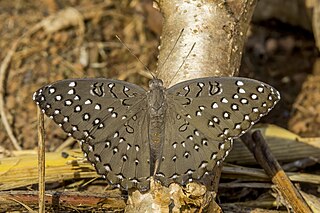
Hamanumida daedalus, the guineafowl butterfly, is a butterfly of the family Nymphalidae and only member of the genus Hamanumida.

Antanartia, commonly called (African) admirals, is a genus in the family Nymphalidae found in southern Africa. They live along forest edges and are strongly attracted to rotting fruit and plant juices. For other admirals see genus, Vanessa. Recently, three species traditionally considered to be members of Antanartia have been moved to Vanessa based on molecular evidence. Antanartia borbonica was not sampled by the study, but was purported to belong in Antanartia based on morphological similarity.

Catacroptera is a monotypic butterfly genus of the subfamily Nymphalinae in the family Nymphalidae found in sub-Saharan Africa. The habitat consists of grassland and savanna. Adults are on wing year round, but from September to April in cooler areas.

Aeropetes is a monotypic butterfly genus in the family Nymphalidae. Its only species, Aeropetes tulbaghia, is commonly known as the Table Mountain beauty or mountain pride. It is native to southern Africa, where it occurs in South Africa, Lesotho, Eswatini and Zimbabwe.

Paralethe is a monotypic butterfly genus in the family Nymphalidae. Its one species Paralethe dendrophilus, the bush beauty or forest pride is found in South Africa.
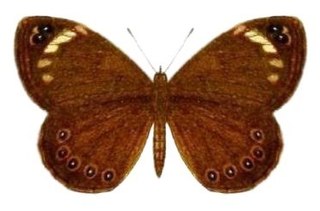
Dira clytus, the Cape autumn widow, is a butterfly of the family Nymphalidae. It is found in South Africa.
Torynesis mintha, the mintha widow, is a butterfly of the family Nymphalidae. It is found in South Africa.

Tarsocera cassina, the sand-dune widow, is a butterfly of the family Nymphalidae. It is found in South Africa in the Western Cape along the coast from Lambert's Bay to Bredasdorp.

Melampias is a monotypic butterfly genus in the family Nymphalidae. Its one species, Melampias huebneri, the Boland brown, is found in South Africa.
Acraea trimeni or Trimen's acraea is a butterfly of the family Nymphalidae. It is found in only in the arid savannah in the northern Northern Cape and the western part of the Free State.
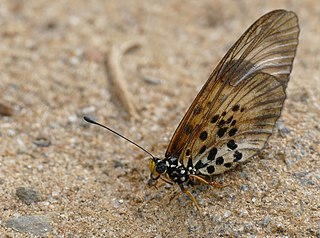
Acraea burni, the pale-yellow acraea, is a butterfly of the family Nymphalidae. It is found in Eswatini, South Africa, Zimbabwe, eastern Zambia and southern Malawi.
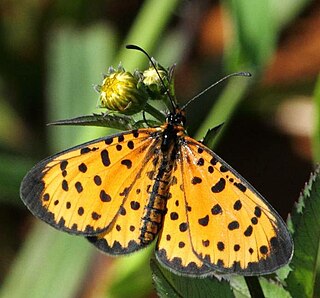
Pardopsis is a monotypic butterfly genus in the family Nymphalidae.
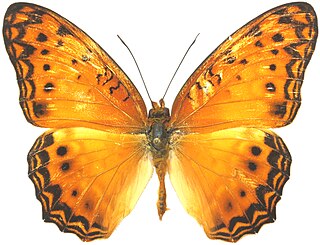
Phalanta eurytis, the forest leopard, forest leopard fritillary, or African leopard fritillary, is a butterfly of the family Nymphalidae. It is found in tropical Africa, Ethiopia, and Sudan.
Charaxes karkloof, the Karkloof emperor, is a butterfly of the family Nymphalidae. It is found in South Africa.

Vanessa dimorphica is a butterfly of the family Nymphalidae. It is found in Africa.

Eurytela hiarbas, commonly known as the pied piper, is a butterfly of the family Nymphalidae, found in Sub-Saharan Africa.
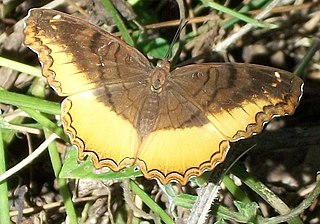
Eurytela dryope, the golden piper, is a butterfly of the family Nymphalidae, found in Sub-Saharan Africa, the Arabian peninsula and Madagascar.
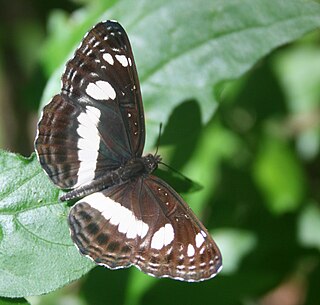
Neptis saclava, the spotted sailer, is a butterfly of the family Nymphalidae. It is native to Madagascar and to large areas of sub-Saharan Africa.

Charaxes cacuthis is a butterfly in the family Nymphalidae. It is found on Madagascar. The habitat consists of lowland and coastal forests.

















